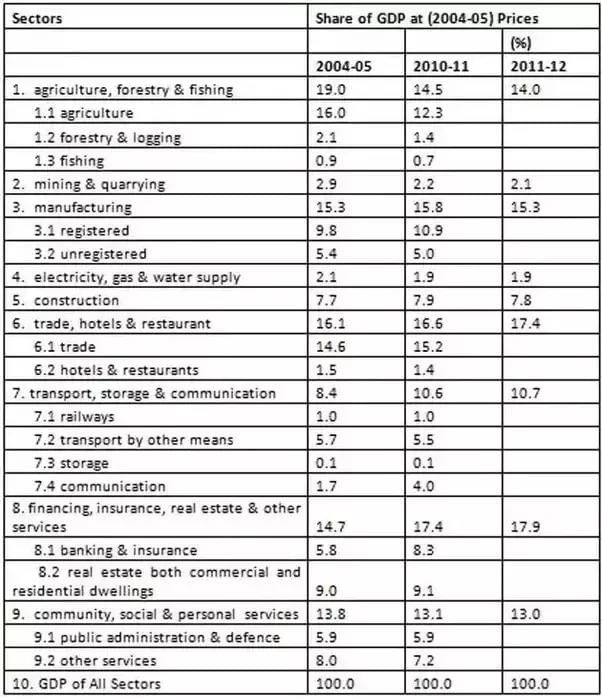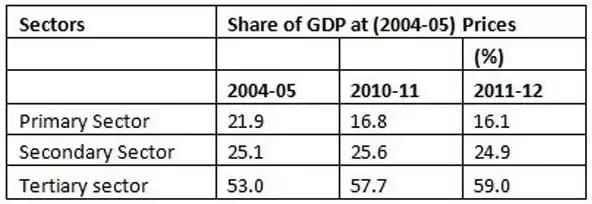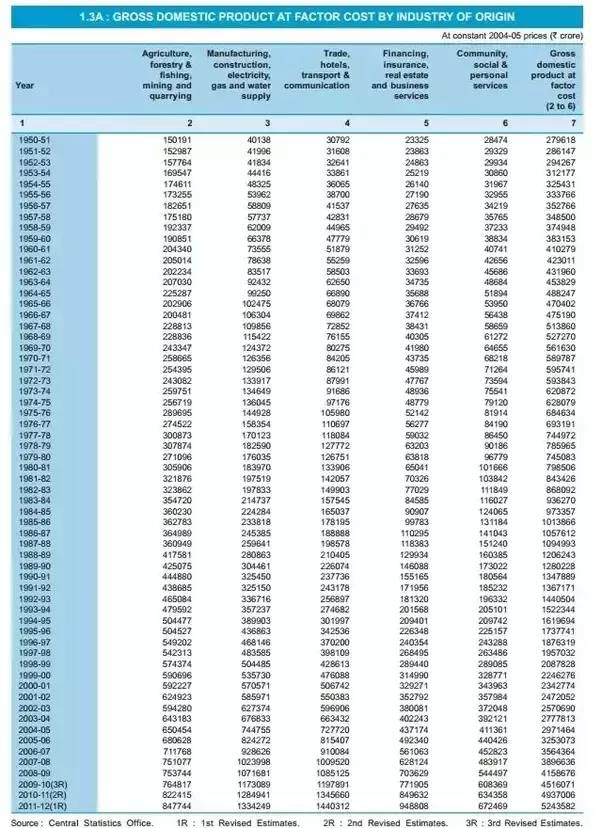The Three-sector Theory - Commerce PDF Download
Ref: https://edurev.in/question/677208/what-is-sector-of-the-Indian-economy-with-structural-diagram-Related-Structure-of-Indian-Economy-Pow
The three-sector theory is an economic theory which divides economies into three sectors of activity: extraction of raw materials (primary), manufacturing (secondary), and services (tertiary). It was developed by Colin Clark and Jean Fourastié.
Primary Sector:
The primary sector of the economy extracts or harvests products from the earth. The primary sector includes the production of raw material and basic foods. Activities associated with the primary sector include agriculture (both subsistence and commercial), mining, forestry, farming, grazing, hunting and gathering, fishing, and quarrying. The packaging and processing of the raw material associated with this sector is also considered to be part of this sector.
In developed and developing countries, a decreasing proportion of workers are involved in the primary sector.
Secondary Sector:
The secondary sector of the economy manufactures finished goods. All of manufacturing, processing, and construction lies within the secondary sector. Activities associated with the secondary sector include metal working and smelting, automobile production, textile production, chemical and engineering industries, aerospace manufacturing, energy utilities, engineering, breweries and bottlers, construction, and shipbuilding.
Tertiary Sector:
The tertiary sector of the economy is the service industry. This sector provides services to the general population and to businesses. Activities associated with this sector include retail and wholesale sales, transportation and distribution, entertainment (movies, television, radio, music, theater, etc.), restaurants, clerical services, media, tourism, insurance, banking, healthcare, and law.
In most developed and developing countries, a growing proportion of workers are devoted to the tertiary sector.
Now coming to the contribution part and why there is an increase or decrease of various sectors in our economy.
Economic growth is divided in to various phases by three-sector theory.
First phase: Traditional civilizations
Workforce quotas:
Primary sector: 70%
Secondary sector: 20%
Tertiary sector: 10%
This phase represents a society which is scientifically not yet very developed, with a negligible use of machinery. The state of development corresponds to that of European countries in the early Middle Ages, or that of a modern-day developing country.
Second phase: Transitional period
Workforce quotas:
Primary sector: 50%
Secondary sector: 30%
Tertiary sector: 20%
More machinery is deployed in the primary sector, which reduces the number of workers needed. As a result, the demand for machinery production in the secondary sector increases. The transitional phase begins with an event which can be identified with industrialisation: far-reaching mechanisation (and therefore automation) of manufacture, such as the use of conveyor belts.
The tertiary sector begins to develop, as do the financial sector and the power of the state.
Third phase: Tertiary civilization
Workforce quotas:
Primary sector: 10%
Secondary sector: 20%
Tertiary sector: 70%
The primary and secondary sectors are increasingly dominated by automation, and the demand for workforce numbers falls in these sectors. It is replaced by the growing demands of the tertiary sector. The situation now corresponds to modern-day industrial societies and the society of the future, the service or post-industrial society.
Today the tertiary sector has grown to such an enormous size that it is sometimes further divided into an information-based quaternary sector, and even a quinary sector based on non-profit services.
I am presenting some data related to the division of Indian economy in these sectors.

In direct terms it can be classified into:

This data present the change is sectoral share through out our economic growth:

Now present condition can be compared by this table as well.

After going through these tables you will find that Indian economy is going through transition where the contribution of Primary sector is decreasing with a gradual increase in the rise of tertiary sector.
FAQs on The Three-sector Theory - Commerce
| 1. What is the three-sector theory? |  |
| 2. How does the three-sector theory apply to commerce? |  |
| 3. What are some examples of the tertiary sector in commerce? |  |
| 4. How does the three-sector theory explain economic development? |  |
| 5. What are the implications of the three-sector theory for employment patterns? |  |



















